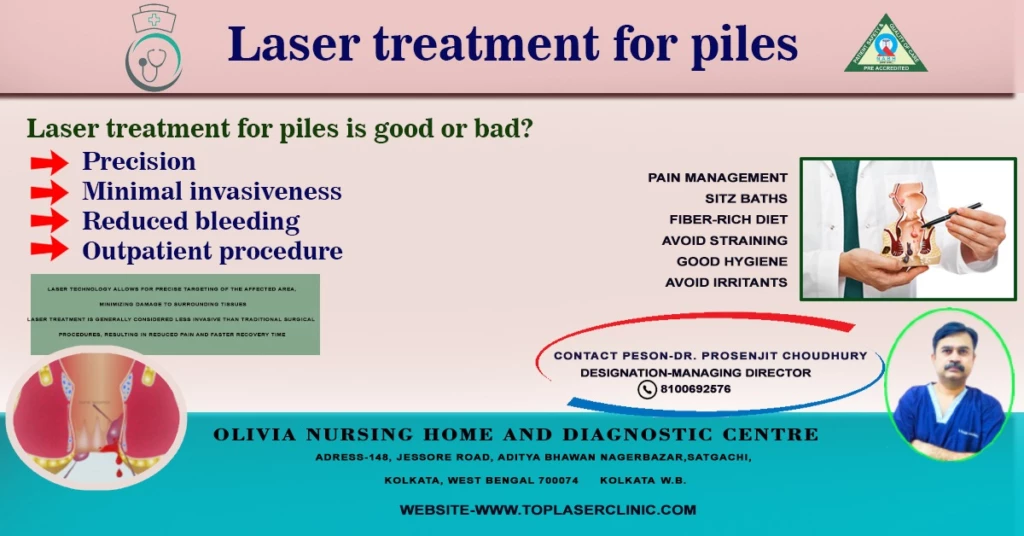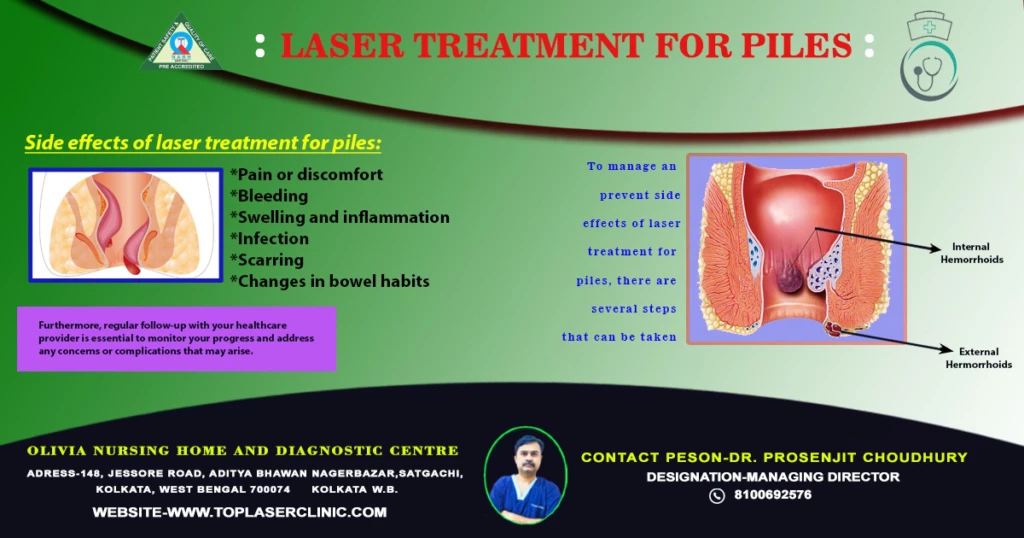
Table of Contents
Laser treatment for piles is good or bad:
Laser treatment for piles, also known as hemorrhoids, has gained popularity in recent years due to its numerous advantages over traditional surgical methods. Laser treatment for piles is considered to be a good option for many patients. However, it is important to note that the appropriateness of laser treatment may vary depending on the severity and type of hemorrhoids, as well as the individual’s overall health condition.
Advantages of laser treatment for piles include:
- Precision: Laser technology allows for precise targeting of the affected area, minimizing damage to surrounding tissues.
- Minimal invasiveness: Laser treatment is generally considered less invasive than traditional surgical procedures, resulting in reduced pain and faster recovery time.
- Reduced bleeding: The laser cauterizes blood vessels during the procedure, leading to reduced bleeding and a lower risk of complications.
- Outpatient procedure: In many cases, laser treatment for piles can be performed on an outpatient basis, allowing patients to return home the same day.
The noninvasive and painless nature of laser treatment for piles makes it a suitable option for patients seeking a less invasive alternative to traditional surgical methods. Studies have indicated that laser treatment for piles can effectively reduce the size of hemorrhoids, alleviate symptoms such as bleeding and pain, and Numerous studies have demonstrated the effectiveness of laser treatment for piles in relieving symptoms, reducing hemorrhoid size, and improving overall quality of life for patients by providing long-term relief.
Additionally, laser treatment for piles is associated with fewer complications and a lower risk of relapse compared to traditional surgical methods:
Effectiveness for severe cases:
Laser treatment may be more suitable for milder cases of hemorrhoids. In more severe cases, alternative treatments or surgical options may be more effective.
Cost:
Laser treatment for piles can be more expensive than other treatment options, as it involves specialized equipment and expertise.
Availability:
Not all healthcare facilities or specialists may offer laser treatment for piles, limiting its accessibility in certain areas.
Potential risks:
Although complications are rare, laser treatment can still carry risks such as infection, scarring, or damage to nearby structures if not performed correctly.
Furthermore, it is always recommended to consult with a healthcare professional to determine the most appropriate treatment option for each individual case.
Side effects of laser treatment for piles:

Among the various treatment options available for piles, laser treatment has gained popularity due to its effectiveness and minimal invasiveness. However, like any medical procedure, laser treatment for piles can also have potential side effects. It is important to understand and consider these potential side effects before opting for laser treatment.These side effects are generally rare and typically mild.
Some possible side effects of laser treatment for piles may include:
Pain or discomfort:
After the procedure, it is common to experience some pain or discomfort in the treated area. This can usually be managed with pain medications prescribed by your healthcare provider.
Bleeding:
Although laser treatment is designed to reduce bleeding during the procedure, there may still be some minimal bleeding afterward. It is typically minor and resolves on its own.
Swelling and inflammation:
Temporary swelling and inflammation of the treated area may occur following laser treatment. This can be managed with ice packs and medications as advised by your doctor.
Infection:
While infection is rare, there is a small risk associated with any medical procedure. It is important to follow proper post-procedure care instructions, including keeping the treated area clean and following any prescribed antibiotic regimen, if applicable.
Scarring:
Laser treatment is generally associated with minimal scarring compared to traditional surgical procedures. However, in rare cases, scarring may occur, particularly if the treatment is not performed correctly or if there are complications.
Changes in bowel habits:
Some individuals may experience temporary changes in bowel habits, such as diarrhea or constipation, following laser treatment. These changes typically resolve within a short period.
Furthermore, the effectiveness of laser treatment for piles may vary depending on factors such as the wavelength or output of the laser and the duration of treatment. Therefore, it is essential to conduct further research to determine the optimal conditions for laser treatment that provide high treatment efficacy. Moreover, it is important to note that laser treatment for piles may not be suitable for all individuals.
In certain cases, such as severe or complicated piles, other treatment options such as hemorrhoidectomy or a combination of procedures may be necessary. In conclusion, while laser treatment for piles is generally considered to be a safe and effective option, it is important to discuss the potential side effects and limitations of laser treatment with a qualified medical professional.
Management and Prevention of Side Effects of laser treatment for piles:
To manage and prevent side effects of laser treatment for piles, there are several steps that can be taken.
Pain management:
Mild to moderate pain may occur after laser treatment. Your healthcare provider may prescribe pain medications or recommend over-the-counter pain relievers to manage discomfort. Applying ice packs to the treated area can also help reduce pain and swelling.
Sitz baths:
Taking warm sitz baths (sitting in a tub filled with warm water) for about 15-20 minutes several times a day can help relieve pain, reduce inflammation, and promote healing. Avoid using any harsh soaps or perfumed products in the bathwater.
Fiber-rich diet:
Consuming a high-fiber diet can help prevent constipation, which is a common trigger for hemorrhoids. Include plenty of fruits, vegetables, whole grains, and legumes in your meals. Adequate hydration is also important to soften stools and ease bowel movements.
Avoid straining:
Straining during bowel movements can worsen hemorrhoids. To prevent this, try not to delay or forcefully strain when you feel the urge to have a bowel movement. If necessary, use stool softeners or fiber supplements recommended by your doctor.
Good hygiene:
Maintaining proper hygiene is crucial to prevent infection and promote healing. Clean the treated area gently with plain water or mild unscented soap and pat it dry with a soft towel. Avoid using rough toilet paper and opt for moistened wipes instead.
Avoid irritants:
Refrain from using harsh soaps, perfumed products, or any other potential irritants in the treated area. These can cause further discomfort or slow down the healing process.
Furthermore, regular follow-up with your healthcare provider is essential to monitor your progress and address any concerns or complications that may arise.